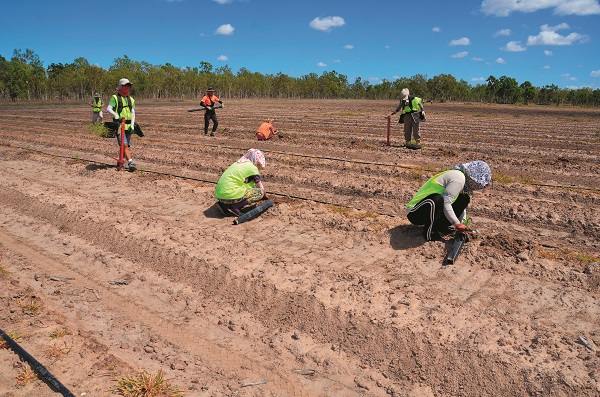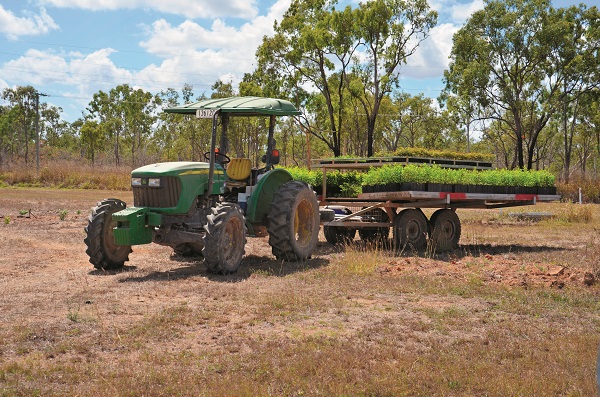Land use is changing as more water infrastructure becomes available. Col Jackson reports on how increased water storage can benefit the northern tropics.
Upriver from Ayr and Home Hill on the Burdekin River, and downstream from the massive Burdekin Dam and its water storage area are the farming communities of Clare, Millaroo and Dalbeg that came into being after World War II as soldier/settlements.
The major crop at that time was tobacco, and while scattered ghostly reminders remain the industry has been deleted from the national agricultural landscape.
Then came sugar cane, and with the completion of the life-giving dam in close proximity, production grew throughout the area. Alternatively, some farmers switched to small cropping.
Since 2012 the landscape has again been changing as vast tracts of land are given over to sandalwood, a crop that requires a copious supply of water.
For an area renowned for its underground supplies, recharging of the aquifers has been necessary to ensure reliable supplies. Thus, water is essential if agriculture is to expand.
While not an isolated example, it gives credibility to Federal agriculture minister Barnaby Joyce’s national initiative to discuss the opportunities and barriers for investment in water infrastructure and dams in Australia.
On October 29, 2014, more than 80 experts involved in water infrastructure across Australia — investors, representatives of irrigators, mining and power industries, financiers, state and territory governments, local governments and construction companies — met in Canberra to discuss this important first step in getting these nation-building projects off the ground.
“Water is wealth and stored water is a bank,” is the minister’s mantra.
“We have before us some great opportunities to build capacity in water infrastructure,” Joyce says.
“We need to strategically plan our future water infrastructure so we can better utilise this precious resource to drive prosperity and improve sustainability in rural industries and regional economies.”
He sounded a warning: “If no new dams are built in the future, Australia’s water storage capacity will fall to 2.6 millilitres per person by 2050. This is a serious issue for us all, and one that the Coalition Government is committed to tackling.”
Another example of how investment in water infrastructure has led to the release of valuable agricultural lands is in the north of Western Australia, where the completion of the Ord River scheme in the late ’60s created Lake Argyle, Australia’s largest artificial lake by volume.
This brought with it not only agricultural development, but research into suitable crops for the tropical north, ranging from melons, pumpkins, chick peas and tropical fruits. Till seven years ago, the Kununurra region — the major town — was the major supplier of pumpkins across the nation.
Another major crop grown the region and marketed worldwide is chia, a small seed that offers the highest combined plant source of omega-3, fibre and protein, alongside a range of vitamins, minerals and anti-oxidants.
Bordering on ‘superfood’ status, chia delivers the maximum amount of nutrients with minimum calories. The nutritional benefits of chia are essentially fibre, omega fatty acids, calcium, anti-oxidants and protein, an excellent source of whole food nutrition.
The expansion of the agricultural scope in the Ord Valley beyond the traditional encouraged tax lawyer Frank Wilson, who has an agriculture and forestry background, to investigate the potential of developing sandalwood plantations in the area.
Sandalwood is a long-term investment taking some 15 years for the tree to reach maturity — that’s before any income after expending an initial $70,000 per hectare to establish the plantation, plus about $5,000 annually in upkeep and maintenance.
Alternatively, when the tree matures and the wood is chipped, between 200kg and 300kg of oil can be expected from each hectare. Each tree will give approximately the equivalent of a bottle of wine in sandalwood oil. The return on investment is massive.
 |
| Sandalwood seedlings at various stages |
According to a report from the Rural Industries Research and Development Corporation (RIRDC) titled Flood Irrigated Tropical Timber Trials in the North of Western Australia there are future prospects that can grow out of the sandalwood industry.
“Sandalwood will create an industry in which the product will be grown and processed in the Ord River Irrigation Scheme before export,” the report states.
“Sandalwood waste from harvesting, together with host biomass that will be removed at the site, may be a product itself and needs to further exploration.
“Like the rum industry, sandalwood could also attract a tourist trade. The industry will thus provide work for a varied range of skills.”
Wilson’s faith in the future potential of a sandalwood industry led to the establishment of the Perth-based Tropical Forestry Services (TFS), the first Australian company to anticipate the future potential of sandalwood.
The initial plantation in the Ord River investment venture began 15 years ago, and was harvested this year.
The entire sandalwood tree is chipped and dispatched to the Mount Romance sandalwood distillery at Albany, in the far south of the state. It is a wholly-owned subsidiary of TFS, and the world’s largest sandalwood distiller.
TFS Corporation is also the world’s largest vertically integrated grower, processor and distiller of Indian sandalwood, a fragrant and medicinal tree valued at more than $100,000 per tonne of heartwood.
The minimum price for sandalwood oil has been US$2,500 per kilogram (A$2,833/kg), but TFS is currently selling for US$4,500/kg (A$5,100/kg). Alternatively, oil from the Australian sandalwood sells for around the US$1,000/kg (A$1,133/kg) mark. It’s the quality of the oil that determines its value.
While the spindly Australian sandalwood (Santalum spicatum) grows naturally and has been harvested in the west since about 1840, the Indian variety (Santalum album) is essentially a rainforest type.
The latter is the more productive traditional type of tree that grows to about 3m, and is a much more prolific provider of sandalwood oil making it a more valuable long-term crop.
From this reasoning, TFS bought the technology to grow Indian sandalwood and set out to raise investment.
 |
| Up to 50 casual and contract employees complement the 10 full-time staff at the Dalbeg operation |
Indian sandalwood grows wild across Asia and can be found in parts of Timor.
Sandalwood has been traded for many thousands of years across the subcontinent, and has established religious and spiritual links that are especially significant to the Hindu and Buddhist faiths.
The oil is used in Chinese medicine, steam distilled to create a resin resembling tobacco that is used for chewing and as a breath freshener, and is commonly used in funeral ceremonies in India.
In more modern times, sandalwood products have become the basis for popular high-end European perfumes and cosmetics. TFS supplies oil to the world’s largest fragrance creator.
Yet sandalwood derives its highest value from pharmaceuticals.
While there is a huge demand for sandalwood oil across the globe, supplies of the primary product — the wood — are diminishing in India due to the inability to grow plantation sandalwood in the country. Additionally, the high cost of sandalwood has fostered an illegal harvesting industry and led to the establishment of a black market across the subcontinent. Illegal poaching also takes place — and this extends into Australia.
Being a hardwood makes it more in demand, but it is the precious oil and its scarcity across the globe that has led to Australia becoming the world major supplier — and TFS is arguably the largest producer of plantation-grown sandalwood in the nation.
Finding the right land and ample supplies of water is a major challenge.
Sandalwood cultivation is water-intensive, and the Ord River scheme holds all the necessary water for such crops. Being a tropical/sub-tropical tree, climate is a major factor in its growth.
Over the past 15 years, new sandalwood plantations have continually been developed in the Ord River Valley. By 2013, some 1,500ha have been planted.
Again, TFS is finding that vast areas across the tropical north where water is plentiful are wide-open to the development of sandalwood plantations. The consortium already has four properties covering 1,500ha in the Northern Territory, where it is establishing new plantations at a cost of $17 million.
Now the Clare/Millaroo/Dalbeg area is taking-on a new vista as sandalwood plantations change the landscape.
The sandalwood is a semi-parasitic tree that must be surrounded by host trees (legumes), enabling the roots to intertwine. It can be categorised in a similar way to how bees host flowers.
For the sandalwood tree to grow, it needs all the support of its host trees, and over the lifetime of the plantation, will draw the life from its hosts.
On the Dalbeg plantation currently undergoing development, farm manager Nigel McGrath takes me through the processes of creating a new plantation.
Starting at the farm shed, a massive array of seedlings create a green mass from which farm workers gather the alternate varieties for delivery into the field.
 |
| A tractor hauls a renewed supply of plants delivered from the TFS seedling facility |
The starter supply of sandalwood seed was purchased from overseas, but since that time TFS has harvested its own seed. While the company has its own specialist team in place, research and development takes time due to the slow growth factor of the sandalwood trees.
Out in the paddocks, a group of mainly Korean backpackers, adequately protected from the blazing sun and glare from the sandy loam soil, follow a tractor hauling the constantly renewed supply of plants that have been delivered from its seedling facility.
Up to 50 casual and contract employees complement the 10 full-time staff at the Dalbeg operation.
There are 505 trees to the hectare, and by the end of this year, there will be more than 900ha under sandalwood in the Dalbeg area. This is in addition to 2,000ha in the Northern Territory and 7,000ha in the Ord River Valley.
Host seedlings are planted by hand, while the sandalwood seedling is mechanically planted via a tube-like apparatus with a foot-operated treadle that creates a hole, inserts the seedling encased in its white tube, and then recovers the earth around it — a simple yet ingenious operation.
Overall, sowing the plantation is a labour-intensive operation.
Then comes the need for a copious supply of water delivered from the Burdekin River nearby.
A few kilometres away are plantations that have experienced prolific growth since the initial planting of the area in 2012. It can be difficult to define the sandalwood from the host trees so early in the growing period.
In the longer term, trees will be pruned to avoid fungal attack, and trunks drilled to determine the strength of the ‘heartwood’, the darker part of the timber that is oil-bearing and hence the most valuable.
The rest of the tree is not wasted, and is used in everything from beads made in China to cremations in India.
A spokesman for TFS says the sandalwood industry has come out of nowhere and is showing enormous prospects for a high-value sustainable market.
“We have the land and the knowledge, and TFS is now consolidating itself in an effort to own more of the plantations rather than lease,” he says.
Currently, 30 per cent of plantations are owned by TFS, and the rest is in the hands of investors.
“Initial investment covers the 15 year life of a plantation,” he adds.
Water infrastructure is the key to expanding agriculture across the tropics.


